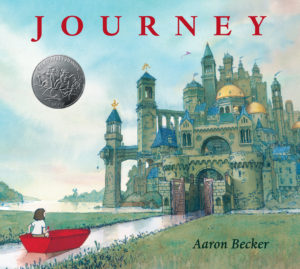[Patreon-Nov16-Post-Bug][/Patreon-Nov16-Post-Bug]The first time I encountered a wordless picture book for children was Journey at my mother’s house nearly a year ago. Long before we had ventured to the library she was already cycling through books for EV every time she visited.
 I gave it a cursory page through and didn’t quite get it. EV didn’t seem to love it, either. I took away that EV wasn’t excited about wordless picture books.
I gave it a cursory page through and didn’t quite get it. EV didn’t seem to love it, either. I took away that EV wasn’t excited about wordless picture books.
Over the summer, E bought EV a wordless book called Pool. I was skeptical of it at first, recalling EV’s disinterest in Journey. Then, I watched something magic begin to happen. E kept making up the story of Pool, and EV began to interact with the story. Sometimes she interjected to add something from a prior telling, others she inserted her own details.
I took a turn reading it to her, and I noticed different facets of it than E, so my telling was a shade different. If I asked nicely enough and didn’t make a big deal about it, EV would even “read” Pool to me.
Pool was one of our most-read books during the summer. When E was listing off books from her want-list for our request list for the library and mentioned Journey, my ears pricked up.
I wondered – how would EV like the book now that she was older and more engaged in the shared creation of a story? Would Journey include both enough narrative and enough ambiguity to make for as interesting a read as Pool?
What a difference a few months made!
The Journey Trilogy: Journey, Quest, and Return by Aaron Becker 
CK Says: ![]() – Try them!
– Try them!
Gender Diversity: Female protagonist; most other characters are male, although background characters are sometimes agender.
Ethnic Diversity: None, unfortunately
Challenging Language: None!
Themes to Discuss: imagination, fantasy, canals, cooperation
Reading Time: Depends on the reader! Between 4-15 minutes each, for us.
The Journey Trilogy by Aaron Becker is a beautiful, brilliant, fantastical trio of wordless adventure books by with a capable little girl hero, each with plenty of room for interpretation and expansion in the retelling. Becker proves himself an ingenious storyteller with an eye for detail and a knack for tantalizing ambiguity.
Journey is the story of a young girl who uses a piece of red chalk to travel to a fantastic world by drawing a door on her bedroom walk. In that world, she learns that the chalk can draw anything out of thin air.
After sailing through a town built on a series of canals, she encounters a group of soldiers flying in zeppelins are trying to catch a vivid purple bird. The girl tries to save the bird, but she’s captured herself, and the two work together so she can get free. The bird leads her to a door just like her own, except it’s the same color as the bird! On the other side, she is back in the real world down the street from her house, where she meets a boy with purple chalk.
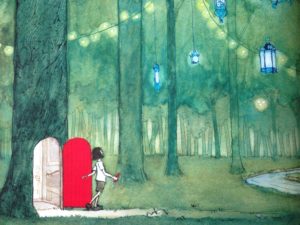 I could add so many more details to that plot summary, but none of them are verifiably true and that’s the best part of Journey. The story told by the series of gorgeous illustrations is never proscriptive, but it includes many hints to act as hooks for your imagination. The colorful chalk creations pop off the watercolor backgrounds.
I could add so many more details to that plot summary, but none of them are verifiably true and that’s the best part of Journey. The story told by the series of gorgeous illustrations is never proscriptive, but it includes many hints to act as hooks for your imagination. The colorful chalk creations pop off the watercolor backgrounds.
The easiest example is the red chalk itself. The girl finds it on the floor of her room. Is it the first time she has encountered it? The natural urge is to say yes, as that fits with how stories like this one are usually told. However, she already owns a matching red scooter and red ball which she has been carrying around the house with her. Is it a coincidence that red is her favorite color, or had she created with the chalk before?
These points of interpretation abound in Journey, and they’re part of what makes it so fun in the retelling. Does the girl mean to steer her little red boat to the top of the highest canal? Is it she or the the bird who engineers the magic carpet that will fit through the bars of her cage? Where do she and the boy find the body of a bike that they draw wheels for at the end of the book?
That’s what makes Journey perfect for a small reader who can interact with you while you read. The details that EV noticed and questions she asked shaped out version of the story. Sometimes it’s a very plain, descriptive version that simply explains the action on each page. Others it unfurls in the telling like a florid fairy tale, full of little asides and descriptions of the girl’s inner monologue.
Journey would already be a surefire recommendation if it stood alone, but Aaron Becker extended the story into two additional books – Quest and Return – that are somehow even more captivating than Journey itself!
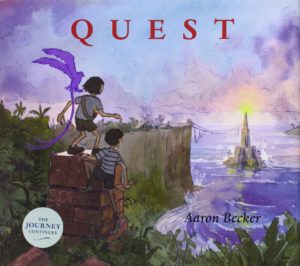 Quest finds the girl and boy accosted in a real world park by a king dressed in yellow, who presses an empty bandolier and a rainbow map before being pulled back through a door to the fantasy world by the guards from the first book. The map depicts four other colors of chalk and the places they can be found. The girl and boy re-enter the world and give the guards a merry chase through the land as they collect the full rainbow of chalk and free the king.
Quest finds the girl and boy accosted in a real world park by a king dressed in yellow, who presses an empty bandolier and a rainbow map before being pulled back through a door to the fantasy world by the guards from the first book. The map depicts four other colors of chalk and the places they can be found. The girl and boy re-enter the world and give the guards a merry chase through the land as they collect the full rainbow of chalk and free the king.
Return begins similarly to Journey – the girl decides to travel to her secret world when her father doesn’t play with her. This time, her father follows her to her room and discovers the open door and the fantastical world on the other side. He finds the girl, boy, and king meeting together, but they’re interrupted with the guards and a machine that can vacuum up their colorful creations – and their chalk! A chase ensues, in which the girl’s father sees all the ingenious ways she’s learned how to use the chalk. However, they have to work together to figure out how to protect the girl’s red chalk from capture and free the king and the boy from the grips of the guards.
There is so much to love in both books, but I’ll simply highlight my favorite element of each.
I love that Quest features an equally capable girl and boy on a wild, fantastical adventure. The added bonus is that the absence of dialog means you can read the pair’s cooperation in whatever manner suits your own little one.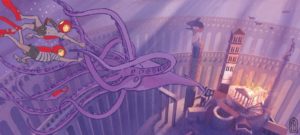 The book gives no indications to their relationship aside from their cooperation.
The book gives no indications to their relationship aside from their cooperation.
My main telling has the boy as much more tentative and unsure than the girl to emphasize how strong encouragement makes her a good leader and friend. However, there are other times I put them on more equal footing, or have them bicker amusingly. Sometimes the girl is cautious, while others she is headstrong and needs to be reeled back in by the boy.
Each person I’ve watched read it with EV gives the pair their own balance. The only thing you cannot really exclude is that the girl is clearly the protagonist of the series.
Return is The Empire Strikes Back of the trilogy, because the introduction of the father to the story includes several potentially mind-blowing revelations that fundamentally change the story depending on how much you fixate on the details of the book.
I don’t want to “spoil” your read by giving you all of our house theories, but here are a few things to notice (which should also give you a good idea of how you can engage 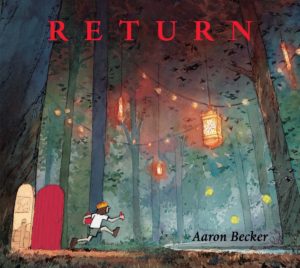 your little one in the illustations of all three books).
your little one in the illustations of all three books).
- The father appears to be drawing at his work desk – what is his job or hobby?
- A door similar to the girl’s can be spotted in the father’s office early in the book. Does it already (or did it ever) lead to the fantasy world?
- The father and the girl both have looks of shock on their faces when they meet in the fantasy world. What is it that surprises each of them? What is it that causes the girl’s subsequent cross-armed reticence?
- The girl and her father encounter a series of seemingly prophetic sketches in a cave. How did they get there?
- Did the father always have the ability to draw in the world with his gray work pencil, or did something happen to cause it to be useful? And, do you think the gray looks similar to the gray of the guard’s armor?
If you read between the lines in those questions, you can see that there is an intriguing meta-narrative about the father that might change the meaning of the prior books depending on your interpretation. This is just one example of how the books open themselves up to growing in the retelling.
When I evaluate if a purchase was worthwhile, I do so on a matrix of dollars invested vs. time enjoyed vs. intensity of enjoyment. If I apply that matrix to the Journey books they are a relatively flat shape of nearly infinity length and width – meaning, they weren’t that expensive but there is no end to the time and amount of enjoyment EV gets from them. She walks around the house with them clutched tightly to her little chest, and will sit for an hour retelling the stories to her stuffed animals and toys.
My sole critique of Journey is that Becker missed an easy opportunity to diversify his cast in making the little boy anything other than white. We don’t meet any of his relatives (OR DO WE?), so his whiteness doesn’t create consistency with any other element of the book. Having him be a kid of color who makes fast friends with the girl and joins in her adventure would only add to the wordless power of these books in displaying friendship, loyalty, and cooperation.
The Journey Trilogy is breathtaking modern classic of fantasy from Aaron Becker that can captivate kids from age 2 to 102. All it takes to enjoy them is an imagination and a willingness to get lost in the beautiful details of his fantasy world. If your toddler isn’t quite enough for it yet, she’ll get there.
